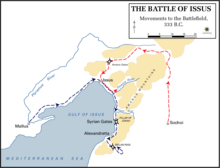Gulf of İskenderun
The Gulf of İskenderun ( Turkish İskenderun Körfezi , Latin Issicus sinus , ancient Greek ὁ Ἰσσοκὸς κόλπος ) is a gulf in the eastern Mediterranean on the Turkish south coast. It forms the northeasternmost point of the Levantine Sea . It is named after the city of İskenderun (also known as Alexandrette). In Roman sources it was also known as Sinus Issicus or Mare Issicum , where Issicus refers to the ancient city of Issus .
geography
The approximately 36 km by 60 km large gulf is bounded in the north and west by the alluvial plain of the Çukurova . The Amanos Mountains form the eastern coast. The area is approximately 1250 km² and the volume of water about 95 km³. The average water depth is between 70 and 80 meters. At the transition point to the Mediterranean, the gulf is 90 meters deep. Important cities on the Gulf are Tarsus , Yumurtalık , Dörtyol and İskenderun in clockwise order .
environment
The Gulf is heavily polluted due to the industry in the coastal cities. In addition, unfavorable ocean currents contribute to contaminated water from the Mediterranean entering the Gulf. Oil pipelines ( Baku-Tbilisi-Ceyhan pipeline ) and heavy industry are located in the cities of İskenderun and Ceyhan . Agricultural waste from Çukurova, which is heavily used for agriculture, reaches the Gulf via the rivers. In 2008 the lagoon at Yumurtalık was designated as the Yumurtalık Lagünü National Park. The national park is 16430 hectares .
history
Along the gulf there is only a narrow strip of land next to the Amanos Mountains. Therefore this region had great strategic value as the bottleneck between Cilicia and Syria . Alexander the Great and Darius III. clashed here in the battle of Issus in 333 BC. After his victory, Alexander founded the city of Alexandreia kat'Isson near the strategically important Beilan mountain pass, replacing Issus as an important city. North of the Gulf is the Cilician Gate , which is the entrance to Central Anatolia . The route along the Gulf also played an important role later, for example in the crusades and in the clashes between the Ottomans and the Egyptian Mamluks .
Individual evidence
- ^ Richard JA Talbert Barrington Atlas of the Greek and Roman World , Princeton University Press, 2000 p. 1032 ISBN 978-0-691-04945-8 at GoogleBooks
- ^ Volume I. Environmental Management within the Context of Environment-Development, p. 39
Web links
- Georg Beer : Issicus sinus . In: Paulys Realencyclopadie der classischen Antiquity Science (RE). Volume IX, 2, Stuttgart 1916, Col. 2246.
- Iskenderun Bay Project. Volume I. Environmental Management within the Context of Environment-Development (PDF; 8.6 MB), project of the United Nations Environment Program
Coordinates: 36 ° 39 ′ 25 ″ N , 35 ° 52 ′ 44 ″ E
